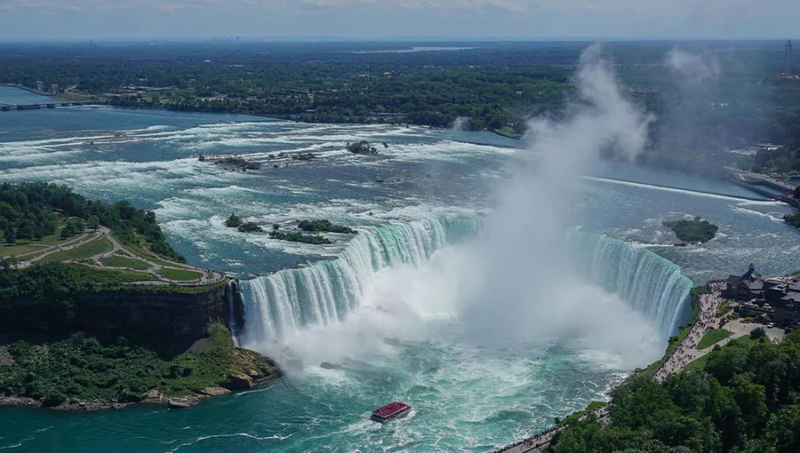Niagara Falls is one of the most iconic natural wonders in North America, drawing millions of visitors each year to the border between the United States and Canada. Niagara Falls is made up of three: the powerful Canadian Horseshoe Falls, the rugged American Falls, and the delicate Bridal Veil Falls. Together, they form a breathtaking spectacle shaped by the Great Lakes and centuries of natural forces. If you're planning to visit and looking into Niagara Falls Tours, read on to learn every thing to know about the 3 waterfalls of Niagara.
Horseshoe Falls
The Canadian Horseshoe Falls is the largest and most famous of the three waterfalls that make up Niagara Falls. Shaped like a giant crescent, it straddles the border between Canada and the United States, with about 90% of it on the Canadian side. Known for its thundering roar and constant veil of mist rising from the base of the falls, it’s the most powerful and visually stunning section of the Niagara River. Here’s some key stats about Horseshoe Falls:
Height:
167 to 188 feet, depending on where it’s measured
Crestline:
Approximately 2,600 feet (792 meters)
Amount of water:
An incredible 600,000 to 681,750 gallons per second
Water flow:
Carries around 90% of the entire flow over Niagara Falls
Geological Features & Erosion
Horseshoe Falls formed as the Niagara River carved through layers of dolostone and softer shale. Its natural curve and heavy water volume contribute to a higher rate of erosion than the other two waterfalls. Modifications in Terrapin Point in 1955 and again in the 1980s helped stabilize the side of the falls, though erosion remains a long-term concern.
Viewing & Activities
To truly grasp the might of Horseshoe Falls, stand at Table Rock or take the Journey Behind the Falls tour, where you’ll hear and feel the force of the water from tunnels cut into the rock. The Maid of the Mist boat tour brings visitors to the very foot of the falls—an unforgettable experience surrounded by mist and sound. Many Niagara Falls Tour Canada packages include this highlight as part of their itineraries. In 2019, pro golfer Maurice Allen even made history by hitting a golf ball across the falls, from Canada to the U.S., landing it near Goat Island.
American Falls
The American Falls is located entirely within New York State, forming one-third of the trio that makes up Niagara Falls. Unlike the sweeping curve of the Horseshoe Falls, the American Falls is known for its rugged, dramatic appearance, shaped by a large talus slope—a pile of rock debris—at its base. This natural formation softens the drop and adds to its striking visual identity from the United States side. Enjoy some interesting stats about the American Falls:
Height:
70 to 110 feet to the talus slope, or 188 feet from crest to river
Crestline:
Approximately 830 to 1,060 feet
Amount of water:
Roughly 75,000 gallons per second
Water flow:
Accounts for about 10% of the flow over Niagara Falls
Geological Features
The American Falls tumbles over a mix of limestone and shale, and over time, erosion has chipped away at its structure. If the process continues, experts suggest it could one day evolve into a series of descending rapids. In 1969, the U.S. Army Corps of Engineers undertook a rare engineering project and temporarily dried out the falls to examine the rockface and study how erosion might be controlled.
Viewing & Activities
Visitors can enjoy some of the closest and clearest views of the falls from Prospect Point, the Observation Tower, or the Crow’s Nest, where mist and thunder combine for a full sensory experience. Unlike the Horseshoe Falls, the American Falls has remained a daredevil-free zone—no one has ever intentionally gone over it in a barrel or other contraption.
Bridal Veil Falls
Nestled between Luna Island and Goat Island, Bridal Veil Falls may be the smallest of the three, but it offers an unforgettable experience. Its delicate stream of water cascades in a soft, misty sheet that resembles a bridal veil—hence the name. Though it flows alongside the American Falls and Bridal Veil Falls share the same source, each has its own distinct charm. Here are some interesting stats about Bridal Veil Falls:
Width:
Approximately 50 to 56 feet
Height:
Ranges from 78 to 103 feet, depending on how it’s measured
Water flow:
Not measured separately; it shares volume with the American Falls
Geological Features
Bridal Veil Falls flows over the same limestone and shale bed as its neighboring falls. Indigenous peoples once called it Pohono, meaning “Spirit of the Puffing Wind,” a name that reflects the ever-present side mist that dances in the air. Through history, it has also been referred to as Luna Falls and Iris Falls—names that underscore its gentle, ethereal quality.
Viewing & Activities
Visitors can get incredibly close to this waterfall. Walk across Luna Island for an overhead view, or venture down to the Hurricane Deck on the Cave of the Winds tour, where you'll stand mere feet from the fall’s rushing veil. The proximity, power, and mist make this an exhilarating, photo-worthy moment at the side of the falls.
Interesting Facts and Lesser-Known Trivia
Niagara Falls State Park, established in 1885, holds the title of the oldest state park in the United States. Designed by the legendary landscape architect Frederick Law Olmsted, who also created Central Park, the park spans more than 400 acres, including portions of Goat Island and the base of the falls.
Niagara Falls has a long and colorful history of daredevils. In 1901, Annie Edson Taylor, a 63-year-old schoolteacher, became the first person to survive going over the falls in a barrel. In the 1850s, high-wire artist Blondin performed stunts across the gorge, even carrying his manager on his back mid-walk.
On March 29, 1848, the flow over Niagara Falls came to a complete halt due to an ice jam in the Niagara River—the only recorded time the falls have ever stopped.
Niagara Falls has appeared on the silver screen multiple times, including in Marilyn Monroe’s classic film Niagara and the original Superman movie.
Beyond the mist and roar lies an ecosystem teeming with life. The region is home to over 600 species of plants, the rare and elusive black squirrel, and endangered species like the lake sturgeon, making the area not just a geological marvel but also a hub for biodiversity.
Conclusion
From the thundering Canadian Horseshoe Falls to the rugged majesty of the American Falls and the delicate mist of the Bridal Veil Falls, each waterfall offers its own unique spectacle—distinct in scale, shape, and sound. Yet together, they form one of the most iconic natural wonders in North America, a place where geology, history, and culture converge at the edge of awe.
Carved by fossil water from the Great Lakes, shaped by time, and revered across generations, Niagara Falls is far more than a postcard view—it's a living force of nature and a symbol of resilience and wonder.


